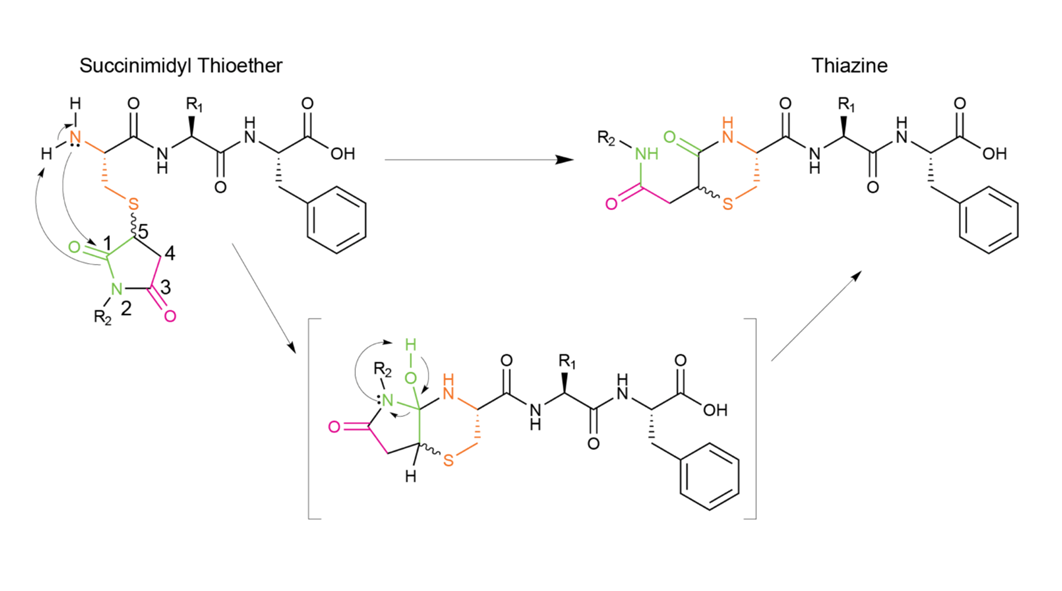By Bachem AG
Bachem research team addresses thiamine formation challenge
Bubendorf, Switzerland: –Peptide technology specialist Bachem has undertaken original research on side reactions that occur in the widely used thiol-maleimide reaction that is so important for the covalent modification of peptides and proteins.
The Bachem study, led by Dr. Isaiah Gober, involved researchers from the Research & Development Department and the CMC Development Group at Bachem Americas, Inc., in Torrance, CA. The full study has been published in the Journal of Peptide Science.
Thiamine formation problems
The team focused on thiazine formation during the conjugation of N-terminal cysteine peptides to maleimides as a side reaction that is under-reported in the peptide literature. Formation of thiazine impurity can complicate the purification, characterization, and storage of peptide conjugates and may lead to significant product loss where succinimidyl thioether linkage is intended in the final product. Since succinimidyl thioether and thiazine isomers have identical molecular weights, it is not easy to distinguish the two using routine liquid chromatography–mass spectrometry (LC–MS).
The study contributes new understanding of the mechanisms of thiamine formation and proposes new tools for preventing it.
Thiol-maleimide coupling
The thiol-maleimide reaction is used to add chemical labels onto biomolecules via thiol conjugation such as fluorescent dyes, PEG, radiolabels and small molecules. The advantages of this reaction are the rapid reaction speed between maleimides and thiols and the preferential chemical reaction at a neutral pH. Various side reactions, such as thiazine rearrangement, have been explained by the instability of the joined maleimide-cysteine.
The team observed a significant increase in the rate of thiazine formation at basic pH, which was consistent with previous work indicating that the rearrangement is promoted under basic conditions. The considerable increase in the rate of thiazine formation at higher pH supports a base-dependent mechanism involving nucleophilic attack of the succinimide by the N-terminal amine.
When the researchers substituted the amino acid adjacent to the N-terminal cysteine for various amino acids, they observed generation of the thiazine impurity in all instances, with formation rates varying depending on the specific tripeptide involved. Even using a maleimide linker anticipated to be more stable resulted in substantial thiazine formation, providing additional evidence that the side reaction is general.
Prevention strategies
The team investigated protonation of the N-terminal amino group under acidic condition as a way of preventing the nucleophilic reaction generating formation of thiazine impurities.
Even though performing conjugation under acidic condition near pH 5 prevented thiazine formation, the subsequent purification, storage and application of the peptide conjugates needed to be performed under acidic conditions to avoid loss of succinimidyl thioether. Alternatively, it was possible to perform acetylation of the N-terminal cysteine to prevent thiazine formation.
”Regarding the general nature of the thiazine side reaction, we advised to avoid the use of N-terminal cysteine in peptide conjugates, where the succinimide thioether linkage is desired,” the study comments.
The team also developed a powerful tandem mass spectrometry (MS/MS) strategy for identifying the thiazine isomer that has general applicability and is independent of the N-substitution of the maleimide. This provides excellent analytical utility because MS/MS capabilities are common to many research labs, in contrast to instruments for advanced 2-D NMR experiments and the requisite expertise to perform such experiments, which are rarer.
Industry implications
Bachem has shared highlights of the study and consequent suggestions in a video webinar, with detailed presentation from one of the researchers, Bachem Vice President for CMC Development, Dr. Matteo Villain (See Resources).
Dr. Villain commented:
“Understanding the side-reactions in peptide chemistry is of utmost importance for peptide API production. By conducting this study, we think we were providing to our customers and to the peptide community at large an important insight that will help saving development resources. This is why we conducted this study and are very satisfied with these results.”
“This is an exciting and novel result, which is important to keep in mind if you work with peptides, peptide-dyes, conjugates and peptide-payload conjugates, and is important for the production of peptide active pharmaceutical ingredients (APIs), used in drugs helping patients worldwide,” Dr. Villain added.
About Bachem
Bachem is a leading, innovation-driven company specializing in the development and manufacture of peptides and oligonucleotides. With over 50 years of experience and expertise, Bachem provides products for research, clinical development and commercial application to pharmaceutical and biotechnology companies worldwide and offers a comprehensive range of services.
Bachem operates internationally with headquarters in Switzerland and locations in Europe, the US and Asia. The company is listed on the SIX Swiss Exchange. For further information, see www.bachem.com.
Resources
Click on ‘Sequence sensitivity and pH dependence of maleimide conjugated N-terminal cysteine peptides to thiazine rearrangement’ to read full study.
Click on Bachem webinar Thiamine Formation to view video presentation.
Click on Bachems News to see latest News & Events.


















